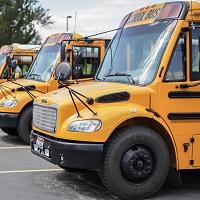 District leaders and an SDP Fellow use data to rapidly arm students with devices in response to coronavirus closures.
District leaders and an SDP Fellow use data to rapidly arm students with devices in response to coronavirus closures.
COVID-19 is blatantly exposing the inequities that have long been under the surface in public education. Districts like that in Central Falls, Rhode Island, feel the inequities inherent in urban districts acutely during the pandemic. The city’s poverty rate is at 30%, and the median annual household income is just over $30,000. “We’re talking generations deep of immense poverty,” explained Jason Midwood, Director of Strategy and development at Central Falls School District.
The district, in which the majority of students had access to a school-loaned device a few years back, was no longer equipped sufficiently with devices when coronavirus hit. “Our fleet of chromebooks was on its last leg," Midwood expanded, "so we knew we couldn’t be one-to-one in time for distance learning. This was our call once school closures were announced. We needed to get as many devices into homes as possible.”
Getting devices into homes sounds simple enough, yet the complexities of doing this in a city with an area of just over one square mile are complicated. “The walls were closing in on us fast,” continued Midwood. Every day, the governor’s announcements were decreasing the amount of people that could gather. First it was 20, then 15, then 10, and so on. “We were really wrestling with two dilemmas. First was getting devices to families, fast. Second was doing so while maintaining the safety of our staff and our families.”
After an initial attempt at enabling families to come pick up a device in person, the team quickly moved to a delivery model with their fleet of school buses. “It just wasn’t safe,” offered SDP Fellow Michael Ricci. “Too many people came.”
Thus, data quickly took center stage as the district teased out who needed devices, where those families were, and how to get the device into their hands. Luckily, a year prior as a side project, Ricci had filtered all of the district families’ addresses through an address verification program called SmartyStreets which checks addresses against the USPS and sends them back in a usable format. This seemingly simple practice of ensuring real and usable addresses proved crucial when the district had to act fast.
“After we knew that pick up wasn’t an option,” explained Katie Gomes, Director of Equity, Empowerment, and Excellence for Students with Disabilities, “we had Michael pull some data on what it would take to get one device to every family in grades 5-8. That was our starting point.” From there, the team met every afternoon and kept going down a grade level. “The data kept coming in, and we were able to keep a flow of devices running out to families.”
Then, once the district was able to get a device into every household in K-12, they started going deeper, getting additional devices to families with more than one student in the home. “Every family with 3 or more elementary students got one less device than the number of children they had. For families with middle and high school students, it became one-to-one,” said Gomes.
This massive push to get devices into homes took place all within 12 days.
“One-to-one devices for just high school students seemed like a pie in the sky before the pandemic hit,” reflected Ricci. “When we started bus delivery after school closures, only 47% of families had access to devices. Two weeks later, 99.86% of families have devices in the home.”
The inequities of an urban district like Central Falls created massive hurdles to ensure students were ready for distance learning, yet the team, armed with data and elbow grease, persevered. “It should not have been this hard to do what we did, but I’m so proud of what the team was able to accomplish,” said Midwood. “Data was one of the main drivers along with some blood, sweat, and tears from people willing to risk their own health and safety so that all of our students had the tools to engage in distance learning, quickly.”
Now in the early stages of summer learning development, these leaders anticipate the need for devices and connection to continue well into the coming months. Now that the district has ensured each family a device, a technology hotline and walk-in help desk have been set up to field questions from families and students adjusting to distance learning. And later this summer, students will be staffing that hotline -- the district will train a high-school student-led geek squad on tech industry best practices and standards to both meet the needs of the community and develop usable skills in youth. These measures speak to the critical adjustments the district is making for distance learning beyond the ‘19-20 school year.
Once in-person learning resumes, the district does not intend to continue equipping each student with a device and will likely collect them back. Yet the future is still unfolding in Central Falls. “In some ways we are ok with the ambiguity right now,” concluded Midwood. “We have learned a ton the last five weeks, and we’ve made mistakes as well. But working together and keeping high expectations, strong communications, and deep engagement with the community is the formula to help us all achieve success in a post-COVID world.”
